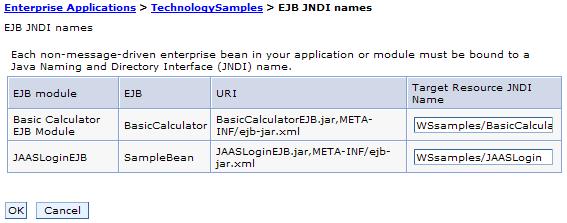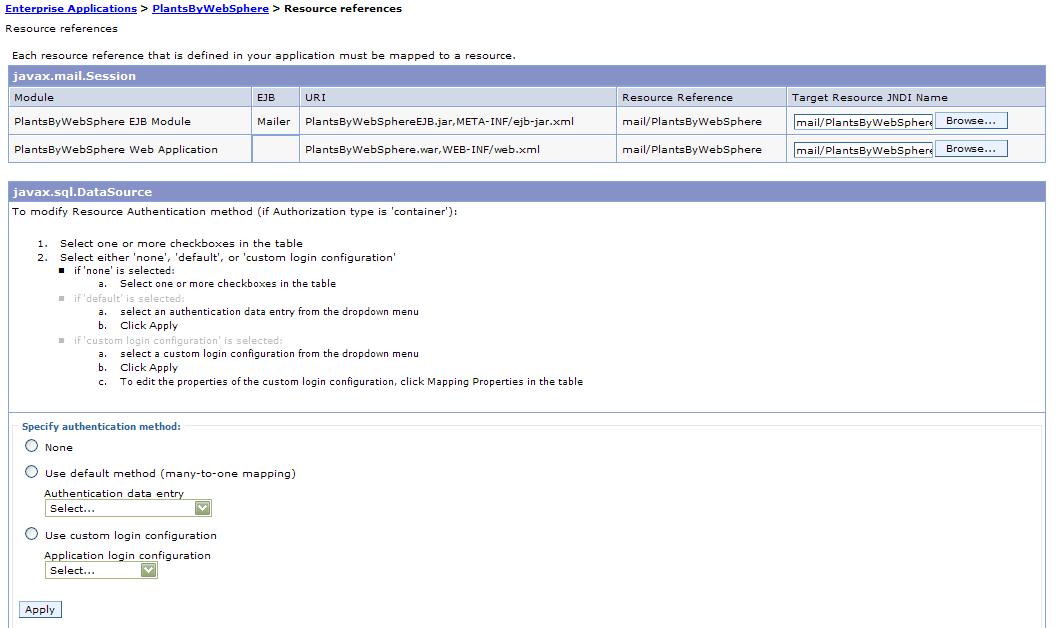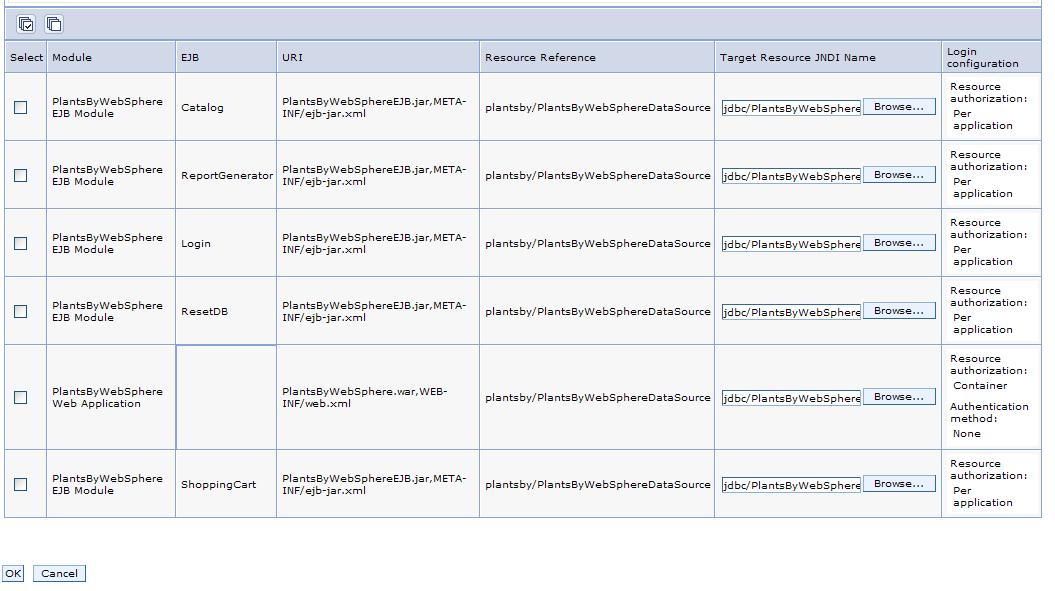Application bindings
Before an application that is installed on an appserver can start, all EJB and resource references defined in the application must be bound to the actual artifacts defined in the appserver.
When defining bindings, you specify JNDI names for the referenceable and referenced artifacts in an application. The jndiName values specified for artifacts must be qualified lookup names. An example referenceable artifact is an EJB defined in an application. An example referenced artifact is an EJB or a resource reference used by the application. Binding definitions are stored in the ibm-xxx-bnd.xmi files of an application. The xxx can be ejb-jar, web, application or application-client.
Times when bindings can be defined
You can define bindings at the following times:
- During application development
An application developer can create binding definitions in ibm-xxx-bnd.xmi, for example, ibm-web-bnd.xmi, using a tool such as an IBM Rational developer tool.
The developer then gives an *.ear file complete with bindings to an application assembler.
When assembling the application, the assembler does not modify the bindings.
Similarly, when installing the application onto a server supported by WAS, the deployer does not modify or override the bindings or generate default bindings unless changes to the bindings are necessary for successful deployment of the application.
- During application assembly
An application assembler can define bindings when modifying deployment descriptors of an application. Bindings are specified in the WebSphere Bindings section of a deployment descriptor editor. Modifying the deployment descriptors might change the binding definitions in the ibm-xxx-bnd.xmi files created when developing an application. After defining the bindings, the assembler gives the application to a deployer. When installing the application onto a server supported by WAS, the deployer does not modify or override the bindings or generate default bindings unless changes to the bindings are necessary for successful deployment of the application.
- During application installation
An application deployer or server administrator can modify the bindings when installing the application onto a server supported by WAS using the console. New binding definitions can be specified on the install wizard pages.
If the deployer or administrator selects to override any existing bindings or to generate default bindings during application installation, default bindings are assigned to the application and new bindings might need to be specified using the console.
Selecting Generate Default Bindings during application installation causes any incomplete bindings in the application to be filled in with default values.
Existing bindings are not changed.
Bindings can be defined or overridden during application installation for all modules except application clients. For clients, define bindings for application client modules during assembly and store the bindings in the ibm-application-client-bnd.xmi file.
- During configuration of an installed application
After an application is installed onto a server supported by WAS, an application deployer or server administrator can modify the bindings by changing values in console pages such as those accessed from the settings page for the enterprise application.
Required bindings
Before an application can be successfully deployed, bindings must be defined for references to the following artifacts:
- EJB JNDI names
- For each enterprise bean (EJB), specify a JNDI name. The name is used to bind an entry in the global JNDI name space for the EJB home object. An example JNDI name for a Product EJB in a Store application might be...
store/ejb/Product
The binding definition is stored in...
META-INF/ibm-ejb-jar-bnd.xmi
If a deployer chooses to generate default bindings when installing the application, the install wizard assigns EJB JNDI names having the form...
prefix/EJB_name
...to incomplete bindings. The default prefix is ejb, but can be overridden.
The EJB_name is as specified in the deployment descriptor tag...
<ejb-name>
During and after application installation, EJB JNDI names can be specified on the Provide JNDI names for beans panel. After installation, click...
Applications | Enterprise Applications | application_name | EJB JNDI names

- Data sources for entity beans
-
Entity beans such as container-managed persistence (CMP) beans store persistent data in data stores.
With CMP beans, an EJB container manages the persistent state of the beans. You specify which data store a bean uses by binding an EJB module or an individual EJB to a data source. Binding an EJB module to a data source causes all entity beans in that module to use the same data source for persistence.
An example JNDI name for a Store data source in a Store application might be...
store/jdbc/store
The binding definition is stored in IBM binding files such as ibm-ejb-jar-bnd.xmi.
A deployer can also specify whether authentication is handled at the container or application level. If a deployer chooses to generate default bindings when installing the application, the install wizard generates the following for incomplete bindings:
- For EJB 2.x .jar files, connection factory bindings based on the JNDI name and authorization information specified
- For EJB 1.1 .jar files, data source bindings based on the JNDI name, data source user name and password specified
The generated bindings provide default connection factory settings for each EJB 2.x .jar file and default data source settings for each EJB 1.1 .jar file in the application being installed. No bean-level connection factory bindings or data source bindings are generated unless they are specified in the custom strategy rule supplied during default binding generation.
After application installation, data sources can be mapped to...
Applications | Enterprise Applications | application_name | 2.x CMP bean data sources
Applications | Enterprise Applications | application_name | 2.x entity bean data sources
Data sources can be mapped to 1.x entity beans on the Map data sources for all 1.x CMP beans panel and on the Provide default data source mapping for modules containing 1.x entity beans panel. After installation, access console pages similar to those for 2.x CMP beans, except click links for 1.x CMP beans.
- For EJB 2.x .jar files, connection factory bindings based on the JNDI name and authorization information specified
- Backend ID for EJB modules
- If an EJB .jar file that defines CMP beans contains mappings for multiple backend databases, specify the appropriate backend ID that determines which persister classes are loaded at run time.
Specify the backend ID during application installation. You cannot select a backend ID after the application is installed onto a server.
To enable backend IDs for individual EJB modules:
- During application installation, select Deploy enterprise beans on the Select installation options panel.
This enables you to access the Provide options to perform the EJB Deploy panel.
- On the Provide options to perform the EJB Deploy panel, set the database type to "" (null).
During application installation, if you select Deploy enterprise beans on the Select installation options panel and specify a database type for the EJB deployment tool on the Provide options to perform the EJB Deploy panel, previously defined backend IDs for all of the EJB modules are overwritten by the chosen database type.
The default database type is DB2UDB_V81.
For information on backend databases, refer to EJB deployment tool. For information on EJB Deploy options, refer to The ejbdeploy command.
- During application installation, select Deploy enterprise beans on the Select installation options panel.
- EJB references
- An enterprise bean (EJB) reference is a logical name used to locate the home interface of an enterprise bean. EJB references are specified during deployment. At run time, EJB references are bound to the physical location (global JNDI name) of the enterprise beans in the target operational environment. EJB references are made available in the java:comp/env/ejb Java naming subcontext.
For each EJB reference, specify a JNDI name. An example JNDI name for a Supplier EJB reference in a Store application might be...
store/ejb/Supplier
The binding definition is stored in IBM binding files such as ibm-ejb-jar-bnd.xmi. When the referenced EJB is also deployed in the same appserver, you can specify a server-scoped JNDI name. But if the referenced EJB is deployed on a different appserver or if ejb-ref is defined in an application client module, then you should specify the global cell-scoped JNDI name.
If a deployer chooses to generate default bindings when installing the application, the install wizard binds EJB references as follows: If an <ejb-link> is found, it is honored. If the ejb-name of an EJB defined in the application matches the ejb-ref name, then that EJB is chosen. Otherwise, if a unique EJB is found with a matching home (or local home) interface as the referenced bean, the reference is resolved automatically.
During and after application installation, EJB reference JNDI names can be specified on the Map EJB references to beans panel. After installation, click...
Applications | Enterprise Applications | application_name | EJB references
- Resource references
- A resource reference is a logical name used to locate an external resource for an application. Resource references are specified during deployment. At run time, the references are bound to the physical location (global JNDI name) of the resource in the target operational environment. Resource references are made available as follows:
Resource reference type Subcontext declared in JDBC data source java:comp/env/jdbc JMS connection factory java:comp/env/jms JavaMail connection factory java:comp/env/mail Uniform Resource Locator (URL) connection factory java:comp/env/url For each resource reference, specify a JNDI name. If a deployer chooses to generate default bindings when installing the application, the install wizard generates resource reference bindings derived from the <res-ref-name> tag, assuming that the java:comp/env name is the same as the resource global JNDI name.
During application installation, resource reference JNDI names can be specified on the Map resource references to references panel. Specify JNDI names for the resources that represent the logical names defined in resource references. You can optionally specify login configuration name and authentication properties for the resource. After specifying authentication properties, click OK to save the values and return to the mapping step. Each resource reference defined in an application must be bound to a resource defined in your WAS configuration. After installation, click...
Applications | Enterprise Applications | application_name | Resource references


- Virtual host bindings for Web modules
- You must bind each Web module to a specific virtual host. The binding informs a Web server plug-in that all requests that match the virtual host must be handled by the Web application. An example virtual host to be bound to a Store Web application might be store_host. The binding definition is stored in IBM binding files such as WEB-INF/ibm-web-bnd.xmi.
If a deployer chooses to generate default bindings when installing the application, the install wizard sets the virtual host to default_host for each .war file.
During and after application installation, you can map a virtual host to a Web module defined in your application. On the Map virtual hosts for Web modules panel, specify a virtual host. The port number specified in the virtual host definition is used in the URL that is used to access artifacts such as servlets and JSP files in the Web module. For example, an external URL for a Web artifact such as a JSP file is http://host_name:virtual_host_port/context_root/jsp_path. After installation, click...
Applications | Enterprise Applications | application_name | Virtual hosts
- Message-driven beans
- For each message-driven bean, specify a queue or topic to which the bean will listen.
A message-driven bean is invoked by a JMS listener when a message arrives on the input queue that the listener is monitoring. A deployer specifies a listener port or JNDI name of an activation specification as defined in a connector module (.rar file) under WebSphere Bindings on the Beans page of an assembly tool EJB deployment descriptor editor.
An example JNDI name for a listener port to be used by a Store application might be StoreMdbListener.
The binding definition is stored in IBM bindings files such as ibm-ejb-jar-bnd.xmi. If a deployer chooses to generate default bindings when installing the application, the install wizard assigns JNDI names to incomplete bindings.
- For EJB 2.x message-driven beans deployed as JCA 1.5-compliant resources, the install wizard assigns JNDI names corresponding to activationSpec instances in the form...
eis/MDB_ejb-name
- For EJB 2.x message-driven beans deployed against listener ports, the listener ports are derived from the message-driven bean <ejb-name> tag with the string Port appended.
During application installation using the console, you can specify a listener port name or an activation specification JNDI name for every message-driven bean on the Bind listeners for message-driven beans panel.
A listener port name must be provided when using the JMS providers:
- Version 5 default messaging
- WebSphere MQ
- generic
An activation specification must be provided when the application's resources are configured using the default messaging provider or any generic J2C resource adapter that supports inbound messaging. If neither is specified, then a validation error is displayed after you click Finish on the Summary panel. Also, if the module containing the message-driven bean is deployed on a 5.x deployment target and a listener port is not specified, then a validation error is displayed after you click Next.
After application installation, you can specify JNDI names and configure message-driven beans on console pages under...
Resources | JMS Providers
...or...
Resources | Resource Adapters
- For EJB 2.x message-driven beans deployed as JCA 1.5-compliant resources, the install wizard assigns JNDI names corresponding to activationSpec instances in the form...
- Message destination references
- A message destination reference is a logical name used to locate an enterprise bean in an EJB module that acts as a message destination. Message destination references exist only in J2EE 1.4 artifacts such as...
- J2EE 1.4 application clients
- EJB 2.1 projects
- 2.4 Web applications
If multiple message destination references are associated with a single message destination link, then a single JNDI name for an enterprise bean that maps to the message destination link, and in turn to all of the linked message destination references, is collected during deployment. At run time, the message destination references are bound to the administered message destinations in the target operational environment.
If a message destination reference and a message-driven bean are linked by the same message destination, both the reference and the bean should have the same destination JNDI name. When both have the same name, only the destination JNDI name for the message-driven bean is collected and applied to the corresponding message destination reference.
If a deployer chooses to generate default bindings when installing the application, the install wizard assigns JNDI names to incomplete message destination references as follows: If a message destination reference has a <message-destination-link>, then the JNDI name is set to ejs/message-destination-linkName. Otherwise, the JNDI name is set to...
eis/message-destination-refName
Other bindings that might be needed
Depending on the references in and artifacts used by your application, you might need to define bindings for references and artifacts not listed in this article.
Related tasks
Configure J2EE applicationsAssembling applications
Deploy J2EE applications